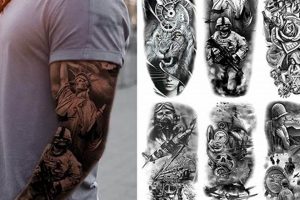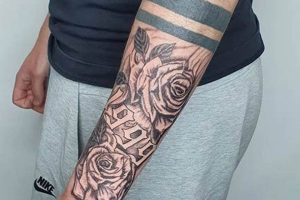A full or half-arm tattoo design, often referred to as a “sleeve,” relies heavily on a well-planned color palette. This involves selecting hues that complement each other, create depth and dimension, and contribute to the overall aesthetic of the design. For instance, a sleeve depicting a Japanese-inspired dragon might utilize vibrant reds, golds, and blues to evoke a sense of power and tradition, while a nature-themed sleeve might employ earthy greens, browns, and muted blues to create a serene and natural feel. The chosen palette can drastically impact the final visual impact and longevity of the tattoo.
The thoughtful use of pigments is crucial for achieving a successful sleeve tattoo. Color selection influences the mood, emphasizes specific elements of the design, and contributes to the long-term vibrancy of the ink. Historically, tattoo pigments were limited, but modern advancements offer an expansive spectrum, allowing for complex shading, gradients, and vivid realism. A knowledgeable artist can guide clients through the nuances of color theory and pigment selection, considering factors like skin tone and desired style.
Exploration of various color palettes and their impact on different tattoo styles, from traditional Japanese to realistic portraiture and abstract watercolor, will further illuminate the significance of color in sleeve designs. Further considerations include the interplay of color with elements like linework, shading, and negative space, all of which contribute to the overall composition and effectiveness of the finished piece.
Color Considerations for Tattoo Sleeves
Careful planning is essential for a visually compelling and enduring sleeve tattoo. The following tips offer guidance on utilizing color effectively in these large-scale designs.
Tip 1: Research Pigment Properties: Different inks have varying properties regarding longevity and vibrancy. Certain colors, particularly lighter shades, may fade more quickly than others. Thorough research and consultation with a reputable artist are recommended.
Tip 2: Consider Skin Tone: Skin tone plays a crucial role in how colors appear. Certain pigments may not be as vibrant on darker skin tones, while others might appear washed out on lighter complexions. A skilled artist can recommend suitable colors that complement individual skin tones.
Tip 3: Plan for Long-Term Visual Impact: Sleeve tattoos are a significant commitment. Consider how the chosen colors will age over time. Bold, saturated colors generally hold up better than delicate pastels.
Tip 4: Explore Color Theory: Understanding color theory, including complementary, analogous, and triadic color schemes, can assist in creating harmonious and visually appealing designs.
Tip 5: Utilize Color for Depth and Dimension: Strategic use of color can create the illusion of depth, volume, and texture within the tattoo. Darker shades can recede, while lighter shades can create highlights and bring elements forward.
Tip 6: Balance Color and Negative Space: The effective use of negative space can enhance the vibrancy of the chosen colors and prevent the design from appearing overcrowded.
Tip 7: Communicate Clearly with the Artist: Open communication with the tattoo artist is crucial. Sharing inspiration, discussing color preferences, and addressing any concerns will contribute to a successful outcome.
By considering these factors, individuals can make informed decisions about color palettes, ensuring a cohesive and impactful sleeve tattoo that stands the test of time.
Through meticulous planning and collaboration with a skilled artist, a vibrant and meaningful sleeve tattoo can be achieved, reflecting individual style and enduring artistic expression.
1. Color Palette
A thoughtfully chosen color palette is paramount to a successful tattoo sleeve. The palette acts as the foundation upon which the entire design rests, influencing not only the aesthetic appeal but also the conveyed message and overall impact. The interplay of colors within a sleeve can evoke specific emotions, create depth and dimension, and contribute to the longevity of the tattoo. A sleeve featuring a realistic portrait, for example, might utilize a muted palette of flesh tones, browns, and blacks to achieve lifelike representation, while a geometric abstract design might employ vibrant, contrasting colors to create a bold, dynamic visual statement.
The relationship between the chosen color palette and the desired style is crucial. Traditional Japanese tattoos, for instance, often feature bold primary colors, rich blacks, and occasional metallic golds, adhering to established conventions and symbolic meanings. Conversely, a watercolor-style sleeve might employ a softer, more fluid palette with blended pastel hues to mimic the effect of watercolors on canvas. Understanding these stylistic nuances and their corresponding color palettes is essential for achieving a cohesive and impactful design. Furthermore, the client’s skin tone must be considered when selecting colors. Certain pigments react differently depending on skin tone; a skilled artist can advise on suitable colors that will maintain their vibrancy over time.
Effective color palette selection requires careful consideration of various factors, including desired style, subject matter, skin tone, and long-term vibrancy of the chosen pigments. Consulting with an experienced tattoo artist is crucial for navigating these complexities. A skilled artist can guide clients through the process of developing a color palette that not only complements their individual style and desired aesthetic but also ensures the longevity and visual impact of the tattoo. Ultimately, a well-chosen color palette is the cornerstone of a successful and enduring tattoo sleeve.
2. Skin Tone Harmony
Achieving skin tone harmony is a critical aspect of successful tattoo sleeve design. Ink interacts differently with varying skin tones, impacting the vibrancy and longevity of the final result. Careful consideration of skin tone ensures the chosen colors appear as intended and age gracefully over time. Ignoring this crucial element can lead to a less impactful and potentially disappointing outcome.
- Color Vibrancy and Saturation
Certain colors appear more vibrant on specific skin tones. Deeper, richer hues often stand out more prominently on darker skin, while lighter, pastel shades might appear washed out. Conversely, lighter skin tones may showcase pastel shades beautifully, while darker, more saturated colors can sometimes overwhelm. For example, a vibrant turquoise might pop on darker skin but appear less intense on lighter skin, while a soft lavender might be subtle and elegant on lighter skin yet barely visible on darker complexions. Understanding these interactions is crucial for selecting colors that complement the canvas.
- Contrast and Visual Impact
The contrast between ink color and skin tone directly affects the tattoo’s visibility and overall impact. High contrast, such as dark ink on light skin or light ink on dark skin, creates a bold, eye-catching design. Lower contrast can achieve subtler, more nuanced effects. For a bold tribal design, high contrast might be desired, whereas a delicate floral piece might benefit from a softer contrast. Careful consideration of contrast allows artists to emphasize specific elements and create visual hierarchy within the design.
- Pigment Fading and Longevity
Skin tone can influence how tattoo ink fades over time. Lighter colors, especially on darker skin tones, are generally more susceptible to fading. Sun exposure and the skin’s natural regenerative processes also contribute to fading. For instance, yellow ink on darker skin might fade more quickly than black ink on the same skin tone. Selecting appropriate colors and employing techniques like bold outlines and strategic shading can help mitigate fading and maintain the tattoo’s integrity over time.
- Consultation and Artist Expertise
Collaboration with an experienced tattoo artist is essential for navigating the complexities of skin tone harmony. A skilled artist possesses the knowledge and expertise to recommend appropriate colors, adjust saturation levels, and employ techniques that optimize the final result for individual skin tones. Open communication and a thorough consultation allow the artist to tailor the design and color palette to achieve the desired aesthetic and ensure long-lasting vibrancy.
By understanding the interplay between skin tone and ink color, individuals can make informed decisions that contribute to a visually stunning and enduring tattoo sleeve. Effective color selection, considering contrast, vibrancy, and longevity, transforms a tattoo into a personalized work of art that complements the individual’s unique canvas.
3. Color Psychology
Color psychology plays a significant role in the effectiveness of tattoo sleeve designs. Colors evoke specific emotional and psychological responses, influencing the overall message and impact of the artwork. Understanding these associations allows for intentional color choices that align with the intended meaning and personal expression of the individual. For instance, red, often associated with passion and energy, might be chosen for a sleeve depicting a fiery phoenix, while blue, often linked to calmness and serenity, might be selected for a sleeve featuring ocean waves and marine life. Careful consideration of color psychology ensures the visual narrative resonates with the wearer’s intent and evokes the desired emotional response in viewers.
The practical application of color psychology in tattoo sleeve design requires a nuanced approach. Cultural interpretations of color can vary significantly, adding layers of complexity to symbolic representation. A color holding positive connotations in one culture might carry different, potentially negative, meanings in another. Furthermore, individual experiences and personal associations with specific colors further personalize the interpretation. Therefore, thorough research and open communication between the artist and client are crucial. Discussing the intended symbolism and exploring personal connections with different colors ensures the final design aligns with the individual’s unique narrative and avoids unintended interpretations.
Integrating color psychology into tattoo sleeve design elevates the artwork beyond mere aesthetics. It imbues the design with deeper meaning, transforming it into a powerful form of personal expression. By acknowledging the psychological impact of color and engaging in thoughtful dialogue, individuals can create visually compelling and emotionally resonant tattoo sleeves that reflect their unique identities and aspirations. Successful integration requires careful consideration of cultural context, personal associations, and the intended emotional impact, ensuring the final piece resonates with both the wearer and the observer. Ultimately, color psychology empowers individuals to communicate narratives, evoke emotions, and create lasting impressions through the art of tattooing.
4. Pigment Vibrancy
Pigment vibrancy is a cornerstone of successful tattoo sleeve design, directly influencing the aesthetic impact and longevity of the artwork. Color saturation, the intensity and purity of a pigment, plays a crucial role in how the tattoo appears initially and how it ages over time. High pigment vibrancy results in bold, eye-catching colors, while low vibrancy leads to muted, less defined hues. This factor is particularly crucial in sleeve designs due to their larger scale and greater visibility. A sleeve composed of vibrant pigments maintains its visual impact over time, while a sleeve using less vibrant pigments might appear faded or washed out as it ages. For instance, a traditional Japanese-style sleeve often relies on highly saturated colors like red, black, and gold to achieve its characteristic boldness, while a watercolor-style sleeve might employ less saturated pigments to create a softer, more ethereal aesthetic. The choice of pigment vibrancy should align with the desired style and long-term aesthetic goals.
Several factors impact pigment vibrancy. Ink quality is paramount; higher quality inks generally offer superior saturation and longevity. Application technique also plays a crucial role. A skilled artist understands how to deposit ink effectively to achieve optimal saturation and minimize trauma to the skin, which can affect healing and color retention. Furthermore, aftercare practices significantly influence long-term vibrancy. Proper moisturizing, sun protection, and avoiding harsh chemicals help preserve color saturation. Neglecting these practices can lead to premature fading and a less vibrant appearance. For example, consistent sun exposure without adequate protection can drastically fade even the most vibrant pigments, particularly lighter shades like yellows and oranges. Conversely, diligent aftercare can significantly extend the lifespan of vibrant colors, ensuring the tattoo maintains its visual appeal for years to come.
Understanding the interplay between pigment vibrancy, ink quality, application technique, and aftercare practices is crucial for achieving and maintaining a visually stunning tattoo sleeve. Informed choices regarding pigment selection, coupled with meticulous artistry and diligent aftercare, contribute to a vibrant, long-lasting piece of art. By considering these factors, individuals can ensure their tattoo sleeves retain their impact and artistic integrity over time, reflecting their initial vision and expressing their personal style with enduring vibrancy. Addressing the potential challenges of pigment fading through proper techniques and maintenance ensures the longevity and continued impact of the chosen design.
5. Artist Collaboration
Effective collaboration with a skilled tattoo artist is paramount when realizing complex color palettes for tattoo sleeves. The artist’s expertise bridges the gap between concept and execution, ensuring the desired color scheme translates effectively onto the skin. This collaborative process involves open communication, shared vision, and a deep understanding of color theory, skin tone interactions, and pigment properties.
- Technical Expertise and Color Theory
Experienced tattoo artists possess in-depth knowledge of color theory, understanding how different hues interact and impact overall design. They can advise on color combinations that create depth, contrast, and visual harmony within the sleeve. This expertise ensures the final palette complements the chosen style and subject matter, resulting in a cohesive and visually appealing piece. For example, an artist might suggest using complementary colors to create a vibrant, energetic feel, or analogous colors for a more harmonious and calming effect.
- Skin Tone Considerations and Pigment Selection
Artists consider individual skin tones when recommending color palettes. Certain pigments react differently with varying skin tones; some may appear more vibrant on darker skin while others might fade more quickly on lighter complexions. Artists guide clients toward pigments that complement their skin tone, ensuring the colors remain vibrant and true over time. They may also suggest adjustments to saturation levels or alternative color choices to optimize the final result. This tailored approach ensures the chosen colors appear as intended and age gracefully.
- Translating Vision into Reality
Collaboration facilitates the translation of a client’s vision into a tangible piece of art. Through discussions and visual aids, artists interpret abstract ideas and translate them into concrete design elements. This process involves exploring different color palettes, considering placement, and incorporating the client’s preferences into the overall composition. The artist’s technical skill ensures the final execution accurately reflects the client’s vision while adhering to artistic principles and technical limitations.
- Technical Application and Pigment Longevity
Proper application technique is crucial for achieving vibrant, long-lasting color saturation. Experienced artists understand how to deposit ink effectively, minimizing trauma to the skin and maximizing pigment retention. They can also advise on aftercare practices that protect the tattoo and preserve its vibrancy over time. This technical proficiency ensures the chosen colors remain vibrant and true, maximizing the longevity of the artwork. For example, artists might use specific needle configurations and techniques to achieve smooth color transitions and prevent blowouts, which can negatively impact color vibrancy.
Through collaborative exploration of color palettes, consideration of skin tone, and skillful application, artists ensure the final tattoo sleeve is a vibrant, personalized expression of the client’s vision. This partnership elevates the tattoo beyond mere aesthetics, transforming it into a meaningful piece of art that reflects individual style and endures the test of time. The synergy between artistic expertise and personal expression is crucial for achieving a truly successful and impactful tattoo sleeve.
Frequently Asked Questions
Addressing common queries regarding color selection and application in sleeve tattoos helps individuals make informed decisions and achieve desired aesthetic outcomes.
Question 1: How does skin tone affect color choice in tattoo sleeves?
Skin tone significantly influences color vibrancy and longevity. Certain pigments appear more vivid on specific skin tones. Darker skin tones often showcase deeper, richer hues effectively, while lighter skin tones may better display pastel shades. Consulting a skilled artist is crucial for selecting colors that complement individual skin tones.
Question 2: What colors are most likely to fade over time?
Lighter colors, particularly pastels and lighter shades of yellow, pink, and green, tend to fade more quickly than darker, more saturated colors. Sun exposure and the skin’s natural regenerative processes contribute to fading. Proper aftercare, including sun protection, can help mitigate fading.
Question 3: How can color be used to create depth and dimension in a sleeve tattoo?
Strategic use of color creates depth and dimension. Darker shades can recede, while lighter shades create highlights and bring elements forward. Color gradients and shading techniques further enhance the illusion of depth and volume.
Question 4: What is the role of color theory in sleeve design?
Understanding color theory aids in creating harmonious and visually appealing palettes. Complementary colors offer high contrast, analogous colors create a sense of unity, and triadic color schemes offer a balanced yet vibrant effect. Applying these principles contributes to a well-composed and aesthetically pleasing sleeve.
Question 5: How important is artist consultation for color selection?
Artist consultation is crucial. Experienced artists possess knowledge of color theory, pigment properties, and skin tone interactions. They guide clients through the selection process, offering expert advice and ensuring the chosen colors align with the desired aesthetic and skin tone.
Question 6: How does color impact the overall style of a tattoo sleeve?
Color significantly influences the style and message of a tattoo sleeve. Traditional Japanese tattoos utilize bold primary colors, while watercolor styles employ softer, blended hues. Realistic portraits rely on muted, lifelike tones. Color choice should align with the desired style and subject matter.
Careful consideration of these aspects ensures a visually impactful and personally meaningful tattoo sleeve. Consulting with a skilled artist is essential for navigating color complexities and achieving desired results.
Exploring various sleeve design examples showcasing diverse color palettes and styles further aids in informed decision-making.
Conclusion
Effective color selection is paramount in realizing impactful and enduring tattoo sleeves. Careful consideration of color palettes, skin tone harmony, color psychology, pigment vibrancy, and artist collaboration ensures a cohesive and personally meaningful design. Understanding the interplay of these elements allows individuals to transform abstract concepts into vibrant, lasting expressions of personal style. From the initial consultation to the final aftercare regimen, color choices significantly influence the overall aesthetic and longevity of the artwork.
A well-executed tattoo sleeve transcends mere aesthetics; it becomes a narrative etched onto the skin, a testament to individual expression and artistic vision. The thoughtful application of color elevates this art form, transforming skin into a canvas where stories unfold and personal narratives find vibrant expression. By embracing the power of color, individuals can create impactful and enduring works of art that resonate with personal meaning and stand the test of time.







